冀教版英语六年级上册教学设计
冀教版小学英语六年级上册Lesson5教学设计
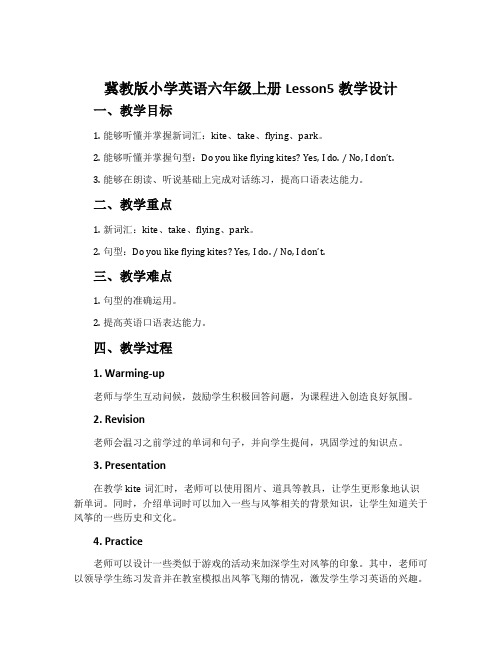
冀教版小学英语六年级上册Lesson5教学设计一、教学目标1.能够听懂并掌握新词汇:kite、take、flying、park。
2.能够听懂并掌握句型:Do you like flying kites? Yes, I do. / No, I don’t.3.能够在朗读、听说基础上完成对话练习,提高口语表达能力。
二、教学重点1.新词汇:kite、take、flying、park。
2.句型:Do you like flying kites? Yes, I do. / No, I don’t.三、教学难点1.句型的准确运用。
2.提高英语口语表达能力。
四、教学过程1. Warming-up老师与学生互动问候,鼓励学生积极回答问题,为课程进入创造良好氛围。
2. Revision老师会温习之前学过的单词和句子,并向学生提问,巩固学过的知识点。
3. Presentation在教学kite词汇时,老师可以使用图片、道具等教具,让学生更形象地认识新单词。
同时,介绍单词时可以加入一些与风筝相关的背景知识,让学生知道关于风筝的一些历史和文化。
4. Practice老师可以设计一些类似于游戏的活动来加深学生对风筝的印象。
其中,老师可以领导学生练习发音并在教室模拟出风筝飞翔的情况,激发学生学习英语的兴趣。
5. Drill老师可以提出以下问题,引导学生进行口语对话练习:•Do you like flying kites?•Yes, I do.•No, I don’t.学生也可以同样的问题向其他同学提出询问,慢慢巩固句型表达。
6. Homework布置一些有关于风筝的复习作业,如绘制风筝、描述风筝的形状大小颜色等等。
五、教学建议1.教师应利用多样化的教材和教具,比如《冀教版小学英语》教材、图片、道具以及教学活动等等,让学生能够在更有趣的环境下学习,提高学生的学习兴趣。
2.在教学中,要尊重学生的学习兴趣和习惯,注重培养学生口语表达的能力。
(冀教版)六年级英语上册 《Lesson 18 Snow! It’s Winter》教学设计设计1
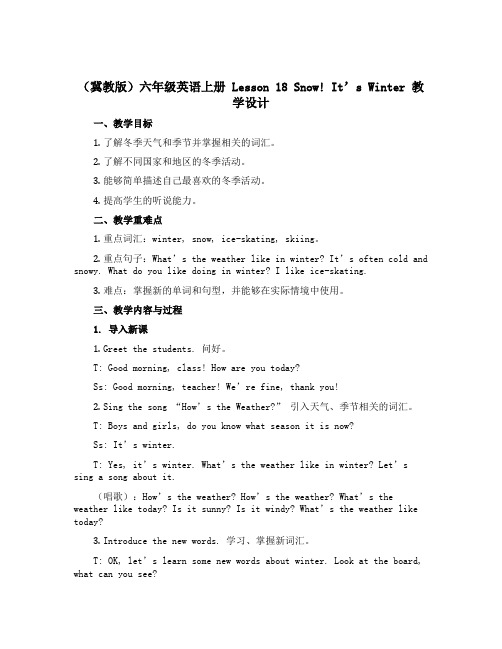
(冀教版)六年级英语上册Lesson 18 Snow! It’s Winter 教学设计一、教学目标1.了解冬季天气和季节并掌握相关的词汇。
2.了解不同国家和地区的冬季活动。
3.能够简单描述自己最喜欢的冬季活动。
4.提高学生的听说能力。
二、教学重难点1.重点词汇:winter, snow, ice-skating, skiing。
2.重点句子:What’s the weather like in winter? It’s often cold and snowy. What do you like doing in winter? I like ice-skating.3.难点:掌握新的单词和句型,并能够在实际情境中使用。
三、教学内容与过程1. 导入新课1.Greet the students. 问好。
T: Good morning, class! How are you today?Ss: Good morning, teacher! We’re fine, thank you!2.Sing the song “How’s the Weather?” 引入天气、季节相关的词汇。
T: Boys and girls, do you know what season it is now?Ss: It’s winter.T: Yes, it’s winter. What’s the weather like in winter? Let’s sing a song about it.(唱歌):How’s the weather? How’s the weather? What’s the weather like today? Is it sunny? Is it windy? What’s the we ather like today?3.Introduce the new words. 学习、掌握新词汇。
冀教版六年级英语上册《Lesson 10 How Many Are There》教案

《Lesson 10 How Many Are There》教案一、教学目标:(1)知识技能:学生能够听、说、读、写单词:word学生能认读,理解并应用下列句型:how many are there?(2)过程与方法:利用游戏复习和引入规则名词的复数,避免语法学习的枯燥。
(3)情感态度:通过游戏的引入,激发学生的英语学习兴趣。
二、教学重点:学生能够掌握不规则名词的复数形式。
三、教学难点:学生能够掌握和在句中灵活运用名词的复数。
四、教学课时 2第一课时Step 2.New conceptsA. 出示实物:T: Hi, class . What is this ?S :It is a pencil .T;Now, what are these ?S:They are pencils .b. Play a game : “WHANT`S WRONG” toreview nouns that fo rm regular plurals . Here are some nouns that form regular plurals that the students already know : book, chair, girl , boy , desk , school , teacher , eraser , pencil , pen , marker , arm , ear , eye , leg , hand , finger , toe ,apple , banana , orange ,stamp ……(教师可以提前做一些单词卡片,把他们贴在黑板上,让学生找出这些单词变复数时的错误。
)出示图片T:Hi , class . What is this ?S : it is a dish .T;Now ,what are these ?S:They are dishes .(从而引出规则单词变复数的形式,用同样的方法,复习三角形引出dresses .) Write “bus , box, watch”on the blackboard .b. Tell Ss the word end in x ,s, sh , ch , they need to add “es” , and pronounce /iz/ . So :Step 3. HomeworkWrite twenty words with s and es第二课时Step 1. Greeting :Hello ,class !How are you today ?How is the weather ?B. Show their words with s oresStep 2. New conceptsa..设置情景(早晨幼儿园学生上学的情景,有送小朋友的家长们)T :Class .(有多少人进校门)Only one man ,one woman and one child ?S : No .T : So many men , women ,and children donate their things for the area . (引出men , children , women .)man ---men woman --- womenchild --- childrenT : Here are some words you know .Do they get bigger with an s or an es ? Tomato potato photod. Play the audiotape and the Ss read these word s after the tap e .e. Play “TIC-TAC-TOE” to practice regular and irregular plur als .f .Do the exerciseFoot----- tooth----- wife----- mouse-----Deer---- fish------ sheep----- person----peopleg. Listening :A ctivity Book No. 2 and No 3.教师的职务是‘千教万教,教人求真’;学生的职务是‘千学万学,学做真人’。
六年级上册英语Unit1教案(冀教版)
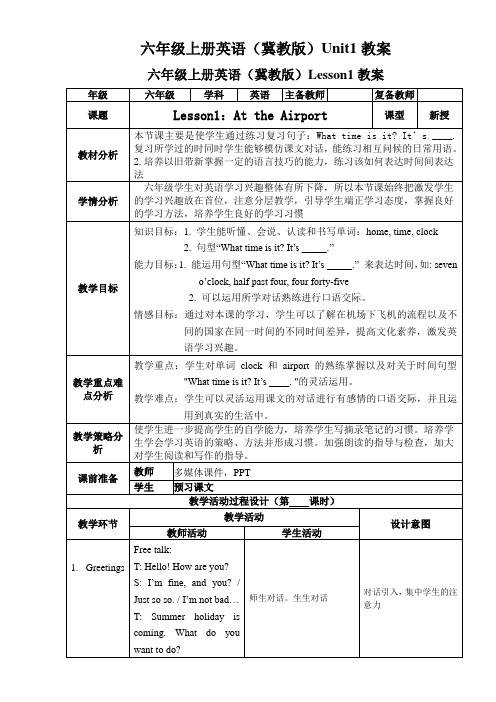
六年级上册英语(冀教版)Unit1教案六年级上册英语(冀教版)Lesson1教案S:I want to go on a trip…T: But on September 1, what will you do?S: I will go back to school.T: Do you know what Li Ming will do on September 1?(Let’s listen)2.New concept S: (after listening) He willgo to school in Canada.T: Why does Li Ming goto school in Canada? Doyou go to school inCanada?S: No.T: So why does Li Minggo to school in Canada?S: He wants to learnEnglish.T: Yes, Li Ming wants togo to school to learnEnglish in Canada. Canyou guess how Li Minggoes to Canada and whathappens?(Please read part 1 andpart 2 silently)T: Can you find somequestions about our text?分小组(Question Teamand Answer Team)Q: 1. When will Li Mingarrive?2.When will Li Ming gohome?根据老师的提问,积极回答问题,完成对话新授环节主要采用对话形式,集中学生的注意力积极利用多媒体的教学手段,丰富课堂效果3.How long will LiMing be in Canada?4.How does Li Mingfeel after the trip?5.Where are Danny andJenny now?(讲airport)S: They are at the airport. T: Yes! What’s this? This is an airport(机场图片). Try to read “port”. sportshort hornT: What about other questions? Let’s go on. (学生继续提问并回答) What time will Li Ming’s plane arrive?S: At five o’clock.T: Good. (出示一个表示5点的钟表) What time is it? It’s five o’clock,Yes, we know the time from the clock.T: What’s this?S: This is a clock.T:Clock! ck k (板书) (chain drills)T: What time is it?S: It’s eight o’clock/ ten o’clock / twelve o’clock./ nine o’clock.T: What time is it now? S: It’s half past four.T: half(做手势) past four.(板书)T: What time do you get up?(示范)出示幻灯图片,学生根据图片提问并回答问题。
六年级冀教版英语上册教学计划(共4篇)

六年级冀教版英语上册教学方案〔共4篇〕第1篇:冀教版六级英语上册教学方案冀教版六年级英语上册教学方案一.课标要求:1.根底教育阶段英语课程的任务是:激发和培养学生学习英语的兴趣,使学生树立自信心,养成良好的学习习惯和形成有效的学习策略,开展自主学习的才能和合作精神;使学生掌握一定的英语根底知识和听、说、读、写技能,形成一定的综合语言运用才能;培养学生的观察、记忆、思维、想象才能和创新精神;帮助学生理解世界和中西方文化的差异,拓展视野,培养爱国精神,形成安康的人生观,为他们的终身学习和开展打下良好的根底。
2.根底教育阶段英语课程的总体目的:根底教育阶段英语课程的总体目的是培养学生的综合语言运用才能。
综合语言运用才能:情感态度:动机兴趣,自信意志,合作精神,祖国意识,国际视野。
学习策略:谁知策略,调控策略,交际策略,资策略。
语言技能:听说读写。
语言知识:语音,词汇,语法,动能,话题。
文化意识:文化知识,文化理解,跨文化交际,意识和才能。
3.对本册课本的要求:对英语学习表现出积极性和初步的自信心。
能听懂有关熟悉话题的语段和简短的故事。
能与老师或同学就熟悉的话题〔如学校、家庭生活〕交换信息。
能读懂小故事及其他文体的简单书面材料。
能参照范例或借助图片写出简单的句子。
能参与简单的角色扮演等活动。
能尝试使用适当的学习方法,克制学习中的困难。
能意识到语言交际中存在文化差异。
二.学情分析^p :学生在小学阶段的最后一年。
通过三年的学习,他们对英语已经有了持续的兴趣和爱好。
三.教材分析^p :1.教学目的:本套教材旨在帮助中国学生学说英语,强调交际和会话,重点在交谈。
教材为学生提供了大量的在各种不同交际情景中用英语进展交谈的时机,学生能经常利用角色表演并自边对话,这些交谈有利于培养学生交流真情实感的才能,促进灵敏的语言运用,使其在各种情景中都能自如地使用英语。
本册教材共分为四个话题功能:our house, school in Canada, winter in Canada and Christmas。
冀教版小学六年级英语上册的教学计划(6篇)

冀教版小学六年级英语上册的教学计划(6篇)冀教版小学六年级英语上册的教学计划篇1一、学情分析六年级的学生对英语学习兴趣整体有所下降,两极分化比较严重。
所以本学期应做好后进生的转化工作。
激发学生学习英语的兴趣,培养他们学习英语的积极态度,使他们初步建立学习英语的自信心,培养学生具有一定的语感和良好的语音、语调、书写基础,以及良好的学习习惯,使他们初步具备用英语进行简单日常交流的能力。
同时培养学生的观察、记忆、思维、想象和创造能力。
教师在教学过程中应强调语言的综合运用,注意学生能力的培养,突出对学生学习兴趣的激发,重视知识的灵活扩展,真正将英语教学的目标落实到实处。
在五年级的对话的基础上,增加了阅读的内容和难度。
本册中所涉及的一般现在时、一般将来时、过去时等句型中对人称、是动词的变化、行为动词的运用对小学生都是一个难点,要打好此部分的基础,为六年级的毕业考试打好基础。
二、教材分析本册教材的特点是:1、强调语言运用。
2、注重能力培养3、突出兴趣激发4、重视双向交流5、融合学科内容6、重视灵活扩展7、实现整体设计。
三、教学目标1、能听、说、读、写61个单词或短语以及7组句子和4个单句。
(包括长度、重量、高度、看病、情感、周末和假期活动、旅行、晚会等几个话题)。
要求能在真实语境中正确运用并能读懂简短语篇。
2、能完成1个手工制作。
3、能听懂、会唱6首歌曲。
4.能听懂并唱6首民谣。
5、能完成四次自我评价活动。
6、能理解6个幽默小故事。
7、能了解6项简单的中西方文化知识。
四、教材重难点、难点1、能按四会、三会的要求掌握所学单词。
2.能够按照第四次会议的要求掌握所学的句型。
3.能够使用日常交流语言,灵活运用四会句型,进行简单交流,语言大胆,发音正确。
4.借助图片、手势和情景等非语言提示,能够理解清晰的文字和录音。
难点:1、一般过去时、一般将来时等几个小学阶段所学句型中对人称、是动词的变化、行为动词的运用。
2.灵活运用四次会议所学的句型:对话、写作和阅读。
(冀教版)六年级英语上册 《Lesson 11 Mr. Wood Teaches a Lesson》
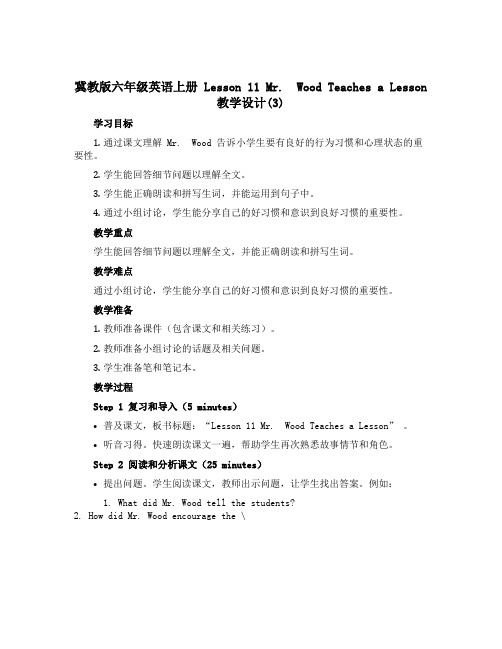
冀教版六年级英语上册 Lesson 11 Mr. Wood Teaches a Lesson
教学设计(3)
学习目标
1.通过课文理解 Mr. Wood 告诉小学生要有良好的行为习惯和心理状态的重要性。
2.学生能回答细节问题以理解全文。
3.学生能正确朗读和拼写生词,并能运用到句子中。
4.通过小组讨论,学生能分享自己的好习惯和意识到良好习惯的重要性。
教学重点
学生能回答细节问题以理解全文,并能正确朗读和拼写生词。
教学难点
通过小组讨论,学生能分享自己的好习惯和意识到良好习惯的重要性。
教学准备
1.教师准备课件(包含课文和相关练习)。
2.教师准备小组讨论的话题及相关问题。
3.学生准备笔和笔记本。
教学过程
Step 1 复习和导入(5 minutes)
•普及课文,板书标题:“Lesson 11 Mr.Wood Teaches a Lesson” 。
•听音习得。
快速朗读课文一遍,帮助学生再次熟悉故事情节和角色。
Step 2 阅读和分析课文(25 minutes)
•提出问题。
学生阅读课文,教师出示问题,让学生找出答案。
例如:
1. What did Mr. Wood tell the students?
2. How did Mr. Wood encourage the \。
冀教版《Lesson13-Seasons》教学设计

冀教版小学英语六年级上册Lesson 13 《Seasons》教学一、Analysis of the teaching materialThe theme of Unit3: Winter in Canada .It mainly describes Li Ming's arrival in Canada where he has spent the winter happily with good friends.And introduced the climate, clothing, sports and so on in winter .In addition, this class is the first class of this unit .It mainly let the students know about the different seasons have different weather in a year .And we wear different clothes in different seasons .Enable the students describe the seasons with some sentences and learn the common sense of life .This class lays the foundation for the teaching of the whole unit.二、Analysis of the studentsIt is the fourth year that students are in sixth grade, and their English basic knowledge system has begun to form.The students have mastered the words and sentences about the weather and clothing. In addition, the teaching content of this lesson is closely related to the students' real life, and it can actively mobilize students' enthusiasm and stimulate the enthusiasm of learning English.三、Teaching objectives1. Goals of knowledge and skills(1) Students will be able to aurally understand ,orally use, recognize and spell the following vocabulary: season, winter, spring, summer, autumn(2)Students will be able to recognize, understand and use these sentences: Winter, spring, summer and autumn are seasons.Winter is cold. There is ice and snow.In winter, I put on my hat, scarf and winter coat.In spring, I take off my winter clothes.2.Goals of process and methodIn the teaching, through games, video, situational dialogues and other forms, enhance the interest of English learning and cultivate students' ability to communicate in English.3.Goals of emotional attitudes and values(1) To cultivate students' love of nature and aesthetic appreciation by understanding the characteristics of different seasons.(2) Through setting up the situation, we will keep the interest of learning English in cooperative learning.4.Key pointsStudents will be able to aurally understand ,orally use, recognize and spell the following vocabulary: season, spring,summer,autumn,winter.Be able to use sentences introduce seasonal climate features and scenery.5.Difficult pointsStudents will be able to recognize、understand and use he following sentences: I take off shorts and T-shirts. I put on my trousers and sweater. In real life, use English to communicate with others about the clothing of different seasons.四、Teaching methodsAs we all know: the main instructional aims of learning English in primary school is to cultivate pupils’ basic abilities of listening and speaking and their good sense of the English language. So in this lesson I’ll mainly use “Task-based” teaching method. That is to say, I will let the students learn in real situations, finish a task by making a survey to help the students to get a better understanding of the key structure of the dialogue. I will arrange four kinds of activities: guessing game, working in group,finishing a survey and having a competition.四、Teaching aidsPPT、some cards、some pictures of clothes、some pictures of clothes、tape五、Teaching time:One class.六、Teaching procedure.:Step 1.warming up1、GreetingT: Hello, boys and girls. Nice to see you. How are you today?S: Very well, thanks.T: How is the weather today?S: It’s sunny/cloudy/windy…….T: How do you feel?S: I feel happy.T: I feel happy, too.2、Let’s watch a video.T: Do you want to watch a video?S: Yes.T: Let’s watch the video together.After watchingT: Is it beautiful?S: Yes.T: Who can tell me what the four parts are?S: We can say the four parts are seasons.T: Good job!Read after me s-e-a-s-o-n season. How many seasons are there ina year?S: Four.T: What are they?S: spring, summer, winter, autumn.T: The whole saying is: Winter, spring, summer and autumn are seasons.Now listen to the tape and repeat.Purpose: It is important to form a better English learning surrounding for the students by watching a video and doing some total physical response and at the same time it provides situations to review learned knowledge for the next step.Step 2 Presentation1、SeasonsT: First of all. Let’s enjoy some pictures and answer me some questions.1、What can you see in this picture?2、How do you feel?3、How is the weather?S: There is__________.I feel___________.It is__________.T: Now can you guess which season it is?S: It is winterT: We can also say: This is winter. Follow me. Winter, winter, winter(from low to aloud)So can you say a sentence with winter.S: This is winter. Winter is cold. There is ice and snow.T: Next every group select a little teacher. And choose one season to complete the following questions according the answers of winter.1、Which season is it? This is______.2、How do you feel? Spring/Summer/Autumn is_________.3、What can you see? There is _________.T: After talking ,which little teacher want to show your answers to your class in front of the classroom. I will give the gifts to the best group.Then listen to the tape and follow it.Purpose: Through the pictures, students can master the word “winter”, and through the teacher's description, students can feel the weather characteristics of winter, and the words are over extended to the sentences, leading the students to say the complete sentences.To make the students actively involved in the classroom. Be the master of learning.The tape can train Students’ abilities of listening and reading.2、Let’s play a guessing game.I will play four voice: the sound of birds, the sound of rain, the sound of fallen leaves, the howling wind. At last, I will give some gifts(fallen leaves )as their rewards to the best group.Purpose: Stimulate students’ interest.3、Different clothes in different clothesT: We all know the weather is different in different seasons, so we wear different clothes in different seasons. Have you remember the words of clothes? Look at these clothes? Do you know them? Let’s race to be the first to answer the question.After thatT: Now it is winter. I feel cold .So I put on my coat. Let’s read it and act it out at the same time. So we can say a sentence with the clothes pictures: In winter, I put on my scarf, hat and winter coat.T: Look at me. What am I doing now?S: Yes, “脱下”So it is “take off” in English.T: Follow me. put on, put on, put on. take off, take off, take off.Next, listen to the tape and choose the right clothes in different seasons.Purpose: Let the students practice the usage of “put on and take off”. And enable the students know different clothes in different seasons.Step 3 PracticeLet’s do it. Open your books and turn to Page39.work in groups and write the answers. At last, I will give some gifts(fallen leaves)as their rewards to the good students.Purpose: Let the students practice to how to describe the seasons.Step4.Conclusion and HomeworkToday’s class is over. Can you tell us what you have learnt in this class?1、Four seasons: season. winter, spring, summer, autumn2、How to say something about the four seasons.3、We wear different clothes in different seasons.4、put on /take off.I design for homework after class, according to the law of the pupil cognition and active nature.1.Make a chant of four season.2.You can draw a picture or take some pictures of your favoriteseason, and write some sentences on it.P urpose: To stimulate students’ interest of learning English and wide their knowledge about communication across cultures.七、layout designLessen13 SeasonsWinter, spring, summer and autumn are seasons.Winter is cold. There is ice and snow.In winter, I put on my hat, scarf and winter coat.In spring, I take off my winter clothes.八、Teaching reflection:This lesson is mainly about the four words of winter, spring, summer, autumn and the different characteristics of the four seasons. And the teaching of two verb phrases of put on, take off. The characteristics of this course is through the different features of the seasons are discussed in different seasons wearing different clothes. If just boring professor, students will be like a monk chanting, not easy to remember, students are very easy to forget. In order to let the students learn something to keep in mind. By setting the students personally feel personally on the scene of the weather features is necessary. At the same time, the use of multimedia to use a lot of pictures make the children play while learning, let them learn, play in the middle of school. Also can cultivate the English language sense, improve the students' oral communication ability. Of course, this lesson also has some shortcomings. Such as :There is a lot of knowledge in this class. Time is limited. So some students may not master well. The students learned today without proper development. In addition, in the process of teaching put not to open, formal, rigid and monotonous, the extension of the traditional one, which is not conducive to mobilize students' learning enthusiasm and interest. I should improve the teaching skill in the following teaching.。
冀教版六年级上册英语教案5篇

冀教版六年级上册英语教案5篇冀教版六年级上册英语教案5篇我们也将会学习如何将所学知识应用于实际生活中,并培养良好的价值观和道德品质。
下面是小编为大家整理的冀教版六年级上册英语教案,如果大家喜欢可以分享给身边的朋友。
冀教版六年级上册英语教案(精选篇1)At the Sports Store教学目标:1.知识目标:能四会单词need,any,or;理解any,some的用法;能灵活使用句子We need some ping-pong balls. Do you have any balls Do you like this T-shirt or that T-shirt I like this one. Do you like these runners or those runners I want these runners.2.能力目标:能利用所学的词汇和句子到商店买东西,提高综合语言运用能力,解决实际生活中的问题。
3.情感目标:让学生学会独立买东西,学会看价钱和计算价格。
教学重、难点:要求四会的单词和要求掌握的句式。
教具、学具准备:1.单词卡片,运动服装,乒乓球,纸币,课后习题卡(每人一张)。
2.录音机或课件。
教学过程:Class Opening and Review1.分给学生不同的球,让学生自己说出I like to play ____. My favourite sport is ____./ I like ____ best.2. T: What’s this/thatS: It’s a T-shirtT: Do you like this T-shirt or that T-shirtS: I like this one.T: What are these/thoseS: They are runners.T: Do you like these runners or those runnersS: I like/want these runners.(设计意图:利用已有知识引出新知识,减小教学的难度,or在以前的教学中已多次用到,学生都已掌握,不必再多费时间,加深学生对this,that,these,those用法的印象为下面的学习做铺垫。
六年级上册英语教学设计- Lesson 3 Making Breakfast 冀教版(三起)
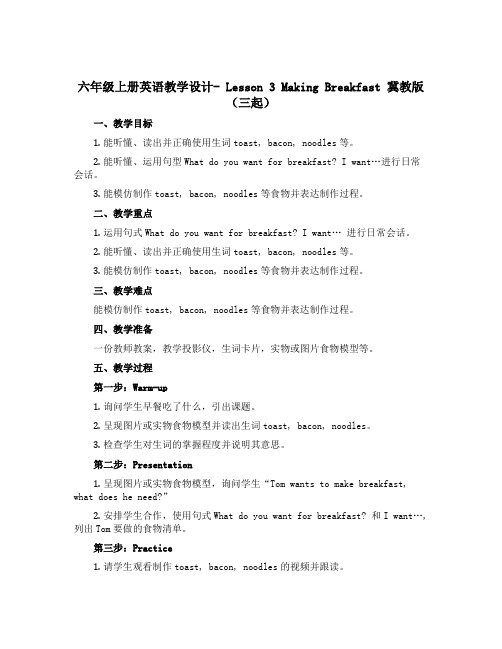
六年级上册英语教学设计- Lesson 3 Making Breakfast 冀教版(三起)一、教学目标1.能听懂、读出并正确使用生词toast, bacon, noodles等。
2.能听懂、运用句型What do you want for breakfast? I want…进行日常会话。
3.能模仿制作toast, bacon, noodles等食物并表达制作过程。
二、教学重点1.运用句式What do you want for breakfast? I want… 进行日常会话。
2.能听懂、读出并正确使用生词toast, bacon, noodles等。
3.能模仿制作toast, bacon, noodles等食物并表达制作过程。
三、教学难点能模仿制作toast, bacon, noodles等食物并表达制作过程。
四、教学准备一份教师教案,教学投影仪,生词卡片,实物或图片食物模型等。
五、教学过程第一步:Warm-up1.询问学生早餐吃了什么,引出课题。
2.呈现图片或实物食物模型并读出生词toast, bacon, noodles。
3.检查学生对生词的掌握程度并说明其意思。
第二步:Presentation1.呈现图片或实物食物模型,询问学生“Tom wants to make breakfast, what does he need?”2.安排学生合作,使用句式What do you want for breakfast? 和I want…, 列出Tom要做的食物清单。
第三步:Practice1.请学生观看制作toast, bacon, noodles的视频并跟读。
2.分组制作认真抄写教材上的食物制作步骤,完成食物制作实践演练。
3.请学生分数为组,相互呈现自己的制作过程,并当场评价。
第四步:Extension1.讨论可以加入哪些食材来制作更多种类的早餐,介绍各种口味和制作方式。
2.安排学生制作其它食物并分享。
冀教版六年级英语上学期全册教案教学设计
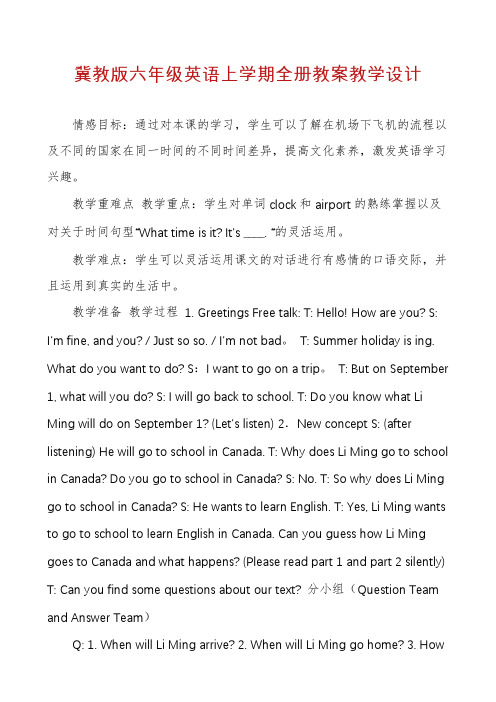
冀教版六年级英语上学期全册教案教学设计情感目标:通过对本课的学习,学生可以了解在机场下飞机的流程以及不同的国家在同一时间的不同时间差异,提高文化素养,激发英语学习兴趣。
教学重难点教学重点:学生对单词clock和airport的熟练掌握以及对关于时间句型“What time is it? It’s ____. “的灵活运用。
教学难点:学生可以灵活运用课文的对话进行有感情的口语交际,并且运用到真实的生活中。
教学准备教学过程1. Greetings Free talk: T: Hello! How are you? S: I’m fine, and you? / Just so so. / I’m not bad。
T: Summer holiday is ing. What do you want to do? S:I want to go on a trip。
T: But on September 1, what will you do? S: I will go back to school. T: Do you know what Li Ming will do on September 1? (Let’s listen) 2.New concept S: (after listening) He will go to school in Canada. T: Why does Li Ming go to school in Canada? Do you go to school in Canada? S: No. T: So why does Li Ming go to school in Canada? S: He wants to learn English. T: Yes, Li Ming wants to go to school to learn English in Canada. Can you guess how Li Ming goes to Canada and what happens? (Please read part 1 and part 2 silently) T: Can you find some questions about our text? 分小组(Question Team and Answer Team)Q: 1. When will Li Ming arrive? 2. When will Li Ming go home? 3. Howlong will Li Ming be in Canada? 4. How does Li Ming feel after the trip? 5. Where are Danny and Jenny now?(讲airport) S: They are at the airport. T: Yes! What’s this? This is an airport(机场图片). Try to read “port”. T: What about other questions? Let’s go on. (学生继续提问并回答) What time will Li Ming’s plane arrive? S: At five o’clock. T: Good. (出示一个表示5点的钟表) What time is it? It’s five o’clock,Yes, we know the time from the clock. T: What’s this? S: This is a clock. T:Clock! ck k (板书) (chain drills)T: What time is it? S: It’s eight o’clock/ ten o’clock / twelve o’clock./ nine o’clock. T: What time is it now? S: It’s h alf past four. T: half(做手势) past four.(板书)T: What time do you get up?(示范)S: At half past six. T:Yes, we usually get up at half past six. S1: What time do you go to school? S2: At half past seven. S3: What time do you go home? S4: At half past eleven.( in pairs) S5: What time do you have supper? S6: I have supper at six fifteen. T: At six fifteen? Can you show us with this clock? (让学生来用手拨表) T: Good. Look! It is 6:15. T:(教师用手来拨)What time is it? S: At four forty-five / five fifteen. T: (game:What time is it?) 出示多组电子表,让学生来问答。
新冀教版六年级上册英语教案完整版

新冀教版六年级上册英语教案集团标准化办公室:[VV986T-J682P28-JP266L8-68PNN]L e s s o n1A t t h e A i r p o r t一、教学目标(一)知识目标1.学生能听懂会读本课课文2.使学生通过练习复习句子:What time is it It’s ____.复习所学过的时间表达法。
(二)能力目标1.学生能够模仿课文对话,能练习相互问候的日常用语。
2.培养以旧带新掌握一定的语言技巧的能力,练习该如何表达时间。
(三)情感目标以情感培养人,培养学生珍惜时间的好习惯。
二、教学重点掌握what time is it It’s_三、教学难点学生能够准确的用英语表达时间。
四、教学用具录音机,磁带五、教学资源 2 : 10 two ten or two past ten. 4 : 30 four thirty or half past four. 9 : 00 nine o’clock or nine. 5 : 45 five forty-five or a quarter to six.六、教学过程:Step 1 : Review1) Play a game: “ The number game” to review number , play with numbers up to ten thousand .2) Review some phrases : What day is it What time is itStep 2 : Presentation and practice1.引出新课题,教授新单词airport,教读数遍并让学生明白单词的意思。
2.Ask and answer:1).Who is this Jenny\Danny\Li Ming.2).Where does Jenny live Canada. Where does Li Ming live China.3)How long is it from September 1 to June 25 Ss count the months: October November December January February…June. Wow!That’sten months.3.Teaching “ What time is it”1) 指着自己的手腕处,ask: What time is it (强调连读is it).Explain that we use “o’clock” only on the hour.2) Demonstrate : Draw a clock on the blackboard.More the hands on the clock as T asks and answer the question . Then get volunteers to answer the question . Eg: 2:40 two forty 5:10 five ten 6:37 six thirty seven 9:00 nine o’clock3.Practice :1) Practice in pairs .2)Ask the volunteers to more the hands on the clock as they ask and answer the question .4.Teaching “ the text ”1)When the students listen to the tape , think over the question :a.Why does LiMing come to Canadab.When does Li Ming arrive When will LiMing go homec.What time did Li Ming’s plane arrived.Who meets him at the airporte.Did he have a good trip2)Read the dialogue and discuss the questions in groups .3)Ask the students to answer the questions .4)Read by themselves , then read role-play .Step 3.HomeworkMake up a dialogue about meeting someone at the airport . Use“ What time is it It’s .”七、 BlackboardLesson 1 At the Airport5 o’clock ——What time is it6 o’clock ——It’s 5:25.教学反思:Lesson2 Jenny’s House一、教学目标:(一)知识目标:1、能听、说、读、写单词:bedroom; kitchen; bathroom; living room ,toilet ,study2、能用英语简单描述自己的家中的各个房间。
冀教版英语六年级上册《I like winter》教学设计
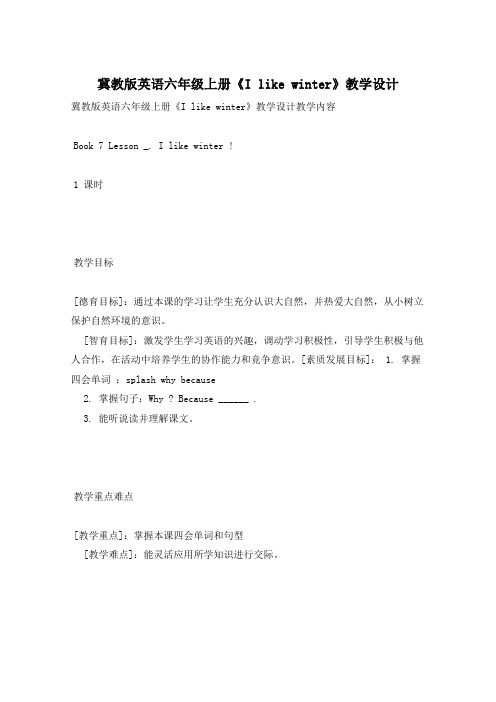
冀教版英语六年级上册《I like winter》教学设计冀教版英语六年级上册《I like winter》教学设计教学内容Book 7 Lesson _. I like winter !1 课时教学目标[德育目标]:通过本课的学习让学生充分认识大自然,并热爱大自然,从小树立保护自然环境的意识。
[智育目标]:激发学生学习英语的兴趣,调动学习积极性,引导学生积极与他人合作,在活动中培养学生的协作能力和竞争意识。
[素质发展目标]: 1. 掌握四会单词:splash why because2. 掌握句子:Why ? Because ______ .3. 能听说读并理解课文。
教学重点难点[教学重点]:掌握本课四会单词和句型[教学难点]:能灵活应用所学知识进行交际。
教学准备课件、张贴画、录音机、挂图等。
学生活动设计小组学习(两人一组、多人一组)、师生互动游戏等It s winter / spring / summer / fall ( autumn )Do you like winter / spring / summer / fall ( autumn ) ? Yes , I do . / No , I don t .喜欢做的事情What do you like to do in ?I like to in .What about you ?I like to in .I like to in , too .三、引入I like to swim in summer .So I like summer . My favourite season is summer .What s your favourite season ?My favourite season is .What s your favourite season ?My favourite season is . (小组比赛:谁的火车开得快)My favourite season is .Why ? ( Draw ? )引导学生读单词,并通过肢体语言的配合来理解这个单词的意思。
最新冀教版小学英六年级上册全册教学设计
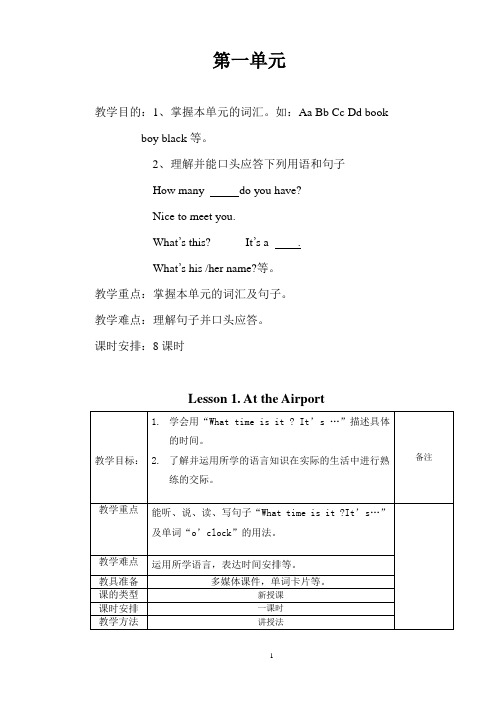
第一单元教学目的:1、掌握本单元的词汇。
如:Aa Bb Cc Dd book boy black等。
2、理解并能口头应答下列用语和句子How many do you have?Nice to meet you.What’s this? It’s a .What’s his /her name?等。
教学重点:掌握本单元的词汇及句子。
教学难点:理解句子并口头应答。
课时安排:8课时Lesson 1. At the AirportLesson 2. Jenny’s houseLesson3:Making BreakfastLesson4:In the BathroomLesson 5: Making Supper ?1112Lesson6: In the living room1315Lesson7 :Are you ready for a quiz ?161718L L e e s s s s o o n n88A A g g a a i i n n P P l l e e a a s s e e19第二单元教学目的:1、掌握以下词江:blue red yellow is on under six seven enght nine ten等。
2、理解并能口头应答下列用语和句子How many do you have?What colour is this? It’s .教学重点:本单元要求掌握的词汇和句子教学难点:理解并能口头应答重点句子。
课时安排:8课时20Lesson 9 On the school busalways usually neverLesson 10 Liming meets Jenny’s classesLesson 11:Mr. Wood Teaches a LessonLesson 12 : How Many Are There ?Lesson 13 : Always Do Your Homework !Lesson 14 Learn a New SongLesson 15 Are You Ready for a Quiz ?Lesson 16 : Again, Please!第三单元教学目的:1、掌握本单元的词汇:arm body ear ellow eye finger hand cold hot 等。
冀教版六年级英语上学期全册教案教学设计
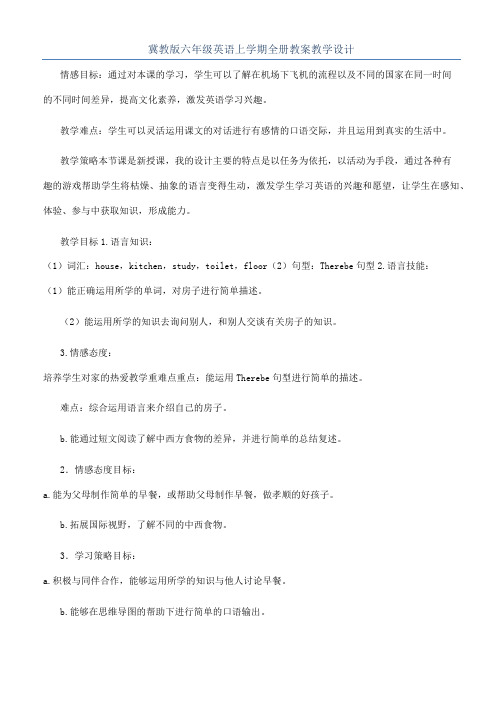
冀教版六年级英语上学期全册教案教学设计情感目标:通过对本课的学习,学生可以了解在机场下飞机的流程以及不同的国家在同一时间的不同时间差异,提高文化素养,激发英语学习兴趣。
教学难点:学生可以灵活运用课文的对话进行有感情的口语交际,并且运用到真实的生活中。
教学策略本节课是新授课,我的设计主要的特点是以任务为依托,以活动为手段,通过各种有趣的游戏帮助学生将枯燥、抽象的语言变得生动,激发学生学习英语的兴趣和愿望,让学生在感知、体验、参与中获取知识,形成能力。
教学目标1.语言知识:(1)词汇:house,kitchen,study,toilet,floor(2)句型:Therebe句型2.语言技能:(1)能正确运用所学的单词,对房子进行简单描述。
(2)能运用所学的知识去询问别人,和别人交谈有关房子的知识。
3.情感态度:培养学生对家的热爱教学重难点重点:能运用Therebe句型进行简单的描述。
难点:综合运用语言来介绍自己的房子。
b.能通过短文阅读了解中西方食物的差异,并进行简单的总结复述。
2.情感态度目标:a.能为父母制作简单的早餐,或帮助父母制作早餐,做孝顺的好孩子。
b.拓展国际视野,了解不同的中西食物。
3.学习策略目标:a.积极与同伴合作,能够运用所学的知识与他人讨论早餐。
b.能够在思维导图的帮助下进行简单的口语输出。
教学重点1.学习四会单词(听懂、会说、认读,书写):breakfast,half,table,put.2.掌握新句子(会听、会说):Whatwouldyoulikeforbreakfast?I’dlike...教学难点:中西文化对比的文章理解。
教具学具食物类单词卡片,早餐制作食材。
教学过程教学环节教师活动学生活动设计意图创设情境激发兴趣G oodmorning.Howareyou?Here’savideoforyou.Whichmealdotheyhave?Let’sspellbreakfast.Toda ywe’regoingtolearnLesson3“MakingBreakfast”.Whomakesbreakfastinyourfamily?Yes,yourpar entsloveyouverymuch.Nowyou’rebigkids,youcanhelpthem.Todaylet’slearntomakebreakfastfor parents.Watchthevideo.Breakfastb-r-e-a-k-f-a-s-tMymother/father.视频内容紧扣主题breakfast,直接把学生引到了今天的课中来。
(冀教版)六年级英语上册 《Lesson 14let’s Sing a New Song》教学设计设
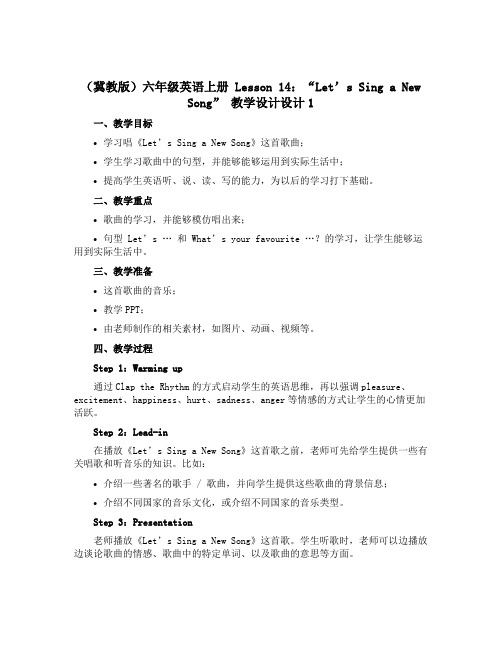
(冀教版)六年级英语上册 Lesson 14:“Let’s Sing a NewSong” 教学设计设计1一、教学目标•学习唱《Let’s Sing a New Song》这首歌曲;•学生学习歌曲中的句型,并能够能够运用到实际生活中;•提高学生英语听、说、读、写的能力,为以后的学习打下基础。
二、教学重点•歌曲的学习,并能够模仿唱出来;•句型Let’s … 和What’s your favourite …?的学习,让学生能够运用到实际生活中。
三、教学准备•这首歌曲的音乐;•教学PPT;•由老师制作的相关素材,如图片、动画、视频等。
四、教学过程Step 1:Warming up通过Clap the Rhythm的方式启动学生的英语思维,再以强调pleasure、excitement、happiness、hurt、sadness、anger等情感的方式让学生的心情更加活跃。
Step 2:Lead-in在播放《Let’s Sing a New Song》这首歌之前,老师可先给学生提供一些有关唱歌和听音乐的知识。
比如:•介绍一些著名的歌手 / 歌曲,并向学生提供这些歌曲的背景信息;•介绍不同国家的音乐文化,或介绍不同国家的音乐类型。
Step 3:Presentation老师播放《Let’s Sing a New Song》这首歌。
学生听歌时,老师可以边播放边谈论歌曲的情感、歌曲中的特定单词、以及歌曲的意思等方面。
Step 4:Practice•在学生听完歌曲之后,老师可以通过给同学分组的方式,在每一组中选择一名学生模拟唱这首歌曲。
•通过每组学生表演歌曲的形式,让学生进一步熟悉这首歌曲的歌词,并让学生在实践中掌握这首歌曲的节奏和感觉。
•在表演完全结束之后,老师可以再次播放这首歌,并邀请全班一齐唱这首歌。
Step 5:Further practice老师可在上一步的基础上继续练习,让学生分组,让他们填空、抽词和拼单词的活动方式来强化学习。
- 1、下载文档前请自行甄别文档内容的完整性,平台不提供额外的编辑、内容补充、找答案等附加服务。
- 2、"仅部分预览"的文档,不可在线预览部分如存在完整性等问题,可反馈申请退款(可完整预览的文档不适用该条件!)。
- 3、如文档侵犯您的权益,请联系客服反馈,我们会尽快为您处理(人工客服工作时间:9:00-18:30)。
冀教版六年级上册英语教案作者Lesson 1 At the Airport一、教学目标(一)知识目标1.学生能听懂会读本课课文。
2.使学生通过练习复习句子:What time is it? It‘s ____.复习所学过的时间表达法。
(二)能力目标1.学生能够模仿课文对话,能练习相互问候的日常用语。
2.培养以旧带新掌握一定的语言技巧的能力,练习该如何表达时间。
(三)情感目标以情感培养人,培养学生珍惜时间的好习惯。
二、教学重点掌握what time is it ? It‘s_三、教学难点学生能够准确的用英语表达时间。
四、教学用具录音机,磁带五、教学资源2 : 10 two ten or ewo past ten.4 : 30 four thirty or half past four.9 : 00 nine o‘clock or nine.5 : 45 five forty-five or a quarter to six.六、教学过程:Step 1 : Review1) Play a game: ― The number game‖ to review number , play with numbers up to ten thousand .2) Review some phrases :What day is it ? What time is it ?Step 2 : Presentation and practice1.引出新课题,教授新单词airport,教读数遍并让学生明白单词的意思。
2.Ask and answer:1).Who is this?JennyDannyLi Ming.2).Where does Jenny live? Canada.Where does Li Ming live? China.3)How long is it from September 1 to June 25?Ss count the months:October November DecemberJ anuary February…June.Wow!That‘sten months.3.Teaching ― What time is it ? ‖1) 指着自己的手腕处,T: What time is it ? (强调连读is it)S:―It‘s ______‖Explain that we use ―o‘clock‖ only on the hour.2) Demonstrate :T draws a clock on the blackboard.More the hands on the clock as T asks and answer the question .Then get volunteers to answer the question .Eg:2:40 two forty5:10 five ten6:37 six thirty seven9:00 nine o‘clock3.Practice :1) Practice in pairs .2)Ask the volunteers to more the hands on the clock as they ask and answer the question .4.Teaching ― the text ‖1)When the students listen to the tape , think over the question :a.Why does LiMing come to Canada (He wants to learn English)b.When does Li Ming arrive ?c.What time did Li Ming‘s plane ar rive ?d.Who meets him at the airport ?e.Did he have a good trip ?2)Read the dialogue and discuss the questions in groups .3)Ask the students to answer the questions .4)Read by themselves , then read role-play .Step 3.HomeworkMake up a dialogue about meeting someone at the airport . Use― What time is it ? It‘s .‖七、BlackboardLesson 1 At the Airport5 o‘clock——What time is it?6 o‘clock——It‘s5:25.Lesson2 Jenny‘s House一、教学目标:(一)知识目标:1、能听、说、读、写单词:room; kitchen; bathroom; living room2、能用英语简单描述自己的家中的各个房间。
(二)能力目标:学生能正确运用英语描述家中的房间,能在创设的情境中进行交流,使语言交际与表达能力进一步得到提高。
(三)情感目标:1、激发学生学习英语的浓厚兴趣,培养学习主动性,感受学英语的乐趣。
2、培养学生要热爱家庭、热爱生活。
二、教学重点、难点:(一)教学重点:能正确运用room; kitchen; bathroom; living room,能准确理解课文内容。
(二)教学难点:能正确理解两个名词性物主代词mine,yours。
三.教具、学具: Some pictures,vocabulary cards ,audiotape and the tape recorder四、教学资源:起居室和客厅的区别简单的说,区别: 客厅主要是用来接待客人的地方,起居室主要是家人一起聊天,看电视的地方。
因为咱们现在的条件有限,一般人家是把客厅和起居室没有分开,一个空间,两种功能。
五、Teaching steps:Step 1. Class Opening1. Greetings:T: Good morning , boys and girls !S: Good morning , Miss Sun !T: How are you today ?S: I‘m fine , thank you . And you ?T: I‘m fine , too . Thank you . Where do you live ?S1: I live in an apartment.S2: I live in a house .Step 2.RevisionUse vocabulary cards to review t he words ― house‖, ―classroom‖, ―bathroom‖ ,―bed‖.Step 3.Key concepts: room, kitchen, bathroom, living room1.Introduce:a. Use posters of rooms to demonstrate each word.b. Point out the word ―room‖ in bathroom, bedroom and living room.c. Free talk:Let the students introduce their rooms and the things in it.2.Student book :a. Play the audiotape as the students follow in their books.b. 1).T: In our book , there are two new words .―mine and yours ‖T: This is my book . This is mine .T: This is my coat . This is mine .T: That is your pencil . That is yours .T: That is your shirt . That is yours .T: Do you know the meaning ?S: Yes . Mine 是我的. Yours 是你的.2).Ss say sentences freely, they should hold some objects in their hands or point to the objects and make the others clear about their meaning.T : ( Point to a book ) This is mineS : This is my book .…….Step 4:Practice:Use a picture-prompt drill. Hold up vocabulary cards for objects found in particular room.T:(Hold up the card for toilet) Where does this go? It goes in the …….S: ……bathroom.T: Very good. It goes in the bathroom. TV, couch and lamp go with kitchen. Bathtub, shower and toilet go with bathroom.Divide the class into small groups. Ask each group to make up a dialogue about showing someone around a new house.Step 5:Consolidation1. Fill the blanks.T: I write some sentences for my house .,but I can‘t write the name of rooms . Can you help me ? S: Fill in the blanks in small groups . Ask one volunteer to show .Step 5:Homework: Write some sentences to describe your rooms in your house.六、板书设计:Lesson 2 Jenny‘s Houseroom kitchen bathroom living roomThis is my bedroom. This is mine.That is your bedroom. That is yours.Lesson 3: Making Breakfast一、教学目标(一)认知目标1.使学生争取掌握(正确地说、读、写、用)单词:make , stove, refrigerator, cook, sink.2.学生能够理解并且掌握句型:What would you like for breakfast? I would like a/an/some____, please.(二)能力目标1. 使学生能进一步掌握更多有关厨房的名词,扩充词汇量。
